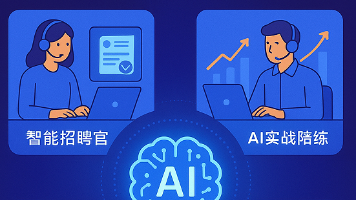AI编程实战:从零基础到智能应用开发
人工智能编程正在重塑技术行业的发展格局。从智能语音助手到自动驾驶汽车,从个性化推荐系统到医疗影像分析,AI技术已广泛应用于各个领域。Python作为最主流的AI开发语言,凭借其简洁的语法和丰富的库生态系统,成为初学者进入AI世界的理想选择。AI编程的核心是让机器具备"学习"能力,从而完成分类、预测、识别等任务。主要包括机器学习深度学习自然语言处理和计算机视觉等方向。与传统编程不同,AI编程更注重从
1 AI编程概述与应用前景

人工智能编程正在重塑技术行业的发展格局。从智能语音助手到自动驾驶汽车,从个性化推荐系统到医疗影像分析,AI技术已广泛应用于各个领域。Python作为最主流的AI开发语言,凭借其简洁的语法和丰富的库生态系统,成为初学者进入AI世界的理想选择。
AI编程的核心是让机器具备"学习"能力,从而完成分类、预测、识别等任务。主要包括机器学习、深度学习、自然语言处理和计算机视觉等方向。与传统编程不同,AI编程更注重从数据中学习规律,而非直接编写规则。
随着大语言模型(LLM)的发展,AI编程的门槛已大幅降低。现代AI工具如Meta的CWM模型具备"沙箱预演"能力,能自动测试代码并修正逻辑错误,甚至拦截危险命令,让即使没有编程基础的普通人也能快速上手。
2 环境搭建与Python基础
2.1 开发环境配置
对于初学者,推荐使用Anaconda发行版,它集成了Python、Jupyter Notebook和常用AI库。
# 创建名为ai_env的虚拟环境
conda create -n ai_env python=3.9
# 激活环境
conda activate ai_env
# 安装必要库
pip install numpy pandas matplotlib scikit-learn tensorflow torch jupyter2.2 Python基础语法
https://simracer.cn/thread-455723-1-1.html
https://simracer.cn/thread-455764-1-1.html
开始AI编程前,需要掌握Python基本语法和数据类型:
# 变量和数据类型示例
name = "AI Learner" # 字符串
age = 25 # 整数
height = 1.75 # 浮点数
is_student = True # 布尔值
# 列表和字典
languages = ["Python", "R", "Java"]
profile = {"name": "AI Learner", "age": 25, "skills": ["Python", "Machine Learning"]}
# 控制流和函数
if age >= 18:
print("Adult")
else:
print("Minor")
def greet(name):
return f"Hello, {name}! Welcome to AI programming."
print(greet("Alex"))3 数据处理与可视化实战
数据是AI模型的基石,高质量的数据处理是成功的关键。
3.1 数据清洗与预处理
https://simracer.cn/thread-455785-1-1.html
https://simracer.cn/thread-455802-1-1.html
import pandas as pd
import numpy as np
from sklearn.preprocessing import StandardScaler
# 读取数据
data = pd.read_csv('data.csv')
# 查看缺失值
print(data.isnull().sum())
# 填充缺失值
data.fillna(method='ffill', inplace=True)
# 删除重复数据
data.drop_duplicates(inplace=True)
# 数据标准化
scaler = StandardScaler()
data_scaled = scaler.fit_transform(data)3.2 数据可视化分析
https://simracer.cn/thread-455826-1-1.html
https://simracer.cn/thread-456008-1-1.html
import matplotlib.pyplot as plt
import seaborn as sns
# 创建示例数据
np.random.seed(42)
data = np.random.randn(100, 3)
df = pd.DataFrame(data, columns=['Feature1', 'Feature2', 'Feature3'])
# 基本统计
print(df.describe())
# 数据可视化
plt.figure(figsize=(10, 6))
plt.hist(df['Feature1'], bins=20, alpha=0.7, label='Feature1')
plt.hist(df['Feature2'], bins=20, alpha=0.7, label='Feature2')
plt.hist(df['Feature3'], bins=20, alpha=0.7, label='Feature3')
plt.legend()
plt.title('Feature Distribution')
plt.xlabel('Value')
plt.ylabel('Frequency')
plt.show()4 机器学习核心算法实战
4.1 线性回归预测房价
以下是一个完整的线性回归示例,用于预测房价。
import numpy as np
import matplotlib.pyplot as plt
from sklearn.linear_model import LinearRegression
# 准备数据(面积与价格)
X = np.array([[50], [60], [70], [80], [90]]) # 特征:面积
y = np.array([100, 120, 140, 160, 180]) # 标签:价格
# 创建并训练模型
model = LinearRegression()
model.fit(X, y)
# 预测新房子价格(例如100平米)
new_area = np.array([[100]])
predicted_price = model.predict(new_area)
print(f"预测100平米的房子价格为:{predicted_price[0]:.2f}万元")
# 可视化结果
plt.scatter(X, y, color='blue', label='真实数据')
plt.plot(X, model.predict(X), color='red', label='拟合直线')
plt.xlabel('面积 (平方米)')
plt.ylabel('价格 (万元)')
plt.title('线性回归模型')
plt.legend()
plt.grid(True)
plt.show()4.2 鸢尾花分类实战
https://simracer.cn/thread-456034-1-1.html
https://simracer.cn/thread-456047-1-1.html
使用K近邻算法进行鸢尾花种类识别。
from sklearn.datasets import load_iris
from sklearn.model_selection import train_test_split
from sklearn.neighbors import KNeighborsClassifier
from sklearn.metrics import accuracy_score, classification_report
# 加载数据
iris = load_iris()
X = iris.data # 特征:花萼长度、花萼宽度、花瓣长度、花瓣宽度
y = iris.target # 标签:鸢尾花种类
# 划分训练集和测试集
X_train, X_test, y_train, y_test = train_test_split(X, y, test_size=0.3, random_state=42)
# 创建KNN分类器(k=3)
knn = KNeighborsClassifier(n_neighbors=3)
knn.fit(X_train, y_train)
# 预测
y_pred = knn.predict(X_test)
# 评估模型
accuracy = accuracy_score(y_test, y_pred)
print(f"模型准确率: {accuracy * 100:.2f}%")
print("\n详细分类报告:")
print(classification_report(y_test, y_pred, target_names=iris.target_names))5 深度学习与神经网络
5.1 手写数字识别(MNIST)
使用Keras构建神经网络识别手写数字。
import tensorflow as tf
from tensorflow.keras import layers, models
import matplotlib.pyplot as plt
# 加载MNIST数据集
mnist = tf.keras.datasets.mnist
(X_train, y_train), (X_test, y_test) = mnist.load_data()
# 数据归一化(像素值从0-255缩放到0-1)
X_train, X_test = X_train / 255.0, X_test / 255.0
# 构建神经网络模型
model = models.Sequential([
layers.Flatten(input_shape=(28, 28)), # 展平输入
layers.Dense(128, activation='relu'), # 全连接层
layers.Dropout(0.2), # 防止过拟合
layers.Dense(10, activation='softmax') # 输出层(10类)
])
# 编译模型
model.compile(optimizer='adam',
loss='sparse_categorical_crossentropy',
metrics=['accuracy'])
# 训练模型
history = model.fit(X_train, y_train, epochs=5, validation_split=0.1)
# 测试模型
test_loss, test_acc = model.evaluate(X_test, y_test)
print(f"\n测试集准确率: {test_acc:.4f}")
# 绘制训练过程中的准确率变化
plt.plot(history.history['accuracy'], label='Training Accuracy')
plt.plot(history.history['val_accuracy'], label='Validation Accuracy')
plt.title('Model Accuracy Over Epochs')
plt.xlabel('Epoch')
plt.ylabel('Accuracy')
plt.legend()
plt.grid(True)
plt.show()5.2 使用TensorFlow进行线性回归
import tensorflow as tf
from tensorflow import keras
import numpy as np
# 准备数据
x = np.array([1, 2, 3, 4, 5], dtype=float)
y = np.array([2, 4, 6, 8, 10], dtype=float)
# 定义模型
model = keras.Sequential([keras.layers.Dense(units=1, input_shape=[1])])
# 编译模型
model.compile(optimizer='sgd', loss='mean_squared_error')
# 训练模型
model.fit(x, y, epochs=500)
# 使用模型进行预测
predictions = model.predict([6.0])
print("Prediction for x=6: ", predictions)6 自然语言处理与AIGC应用
6.1 文本生成实战
使用HuggingFace的Transformers库实现文本生成。
from transformers import GPT2LMHeadModel, GPT2Tokenizer
# 加载预训练模型和分词器
tokenizer = GPT2Tokenizer.from_pretrained('gpt2')
model = GPT2LMHeadModel.from_pretrained('gpt2')
# 生成文本
input_text = "人工智能的未来"
input_ids = tokenizer.encode(input_text, return_tensors='pt')
output = model.generate(input_ids, max_length=50)
generated_text = tokenizer.decode(output[0], skip_special_tokens=True)
print(generated_text)6.2 构建AI编程助手
以下是AI编程助手的核心功能实现。
from transformers import pipeline
import openai
import os
from dotenv import load_dotenv
load_dotenv()
class NLPProcessor:
def __init__(self):
self.summarizer = pipeline("summarization", model="facebook/bart-large-cnn")
self.question_answerer = pipeline("question-answering", model="deepset/bert-base-cased-squad2")
self.text_generator = pipeline("text-generation", model="gpt2")
def summarize_code_doc(self, text, max_length=130, min_length=30):
"""总结代码文档字符串"""
try:
summary = self.summarizer(text, max_length=max_length, min_length=min_length, do_sample=False)
return summary[0]['summary_text']
except Exception as e:
print(f"Summarization error: {e}")
return text[:130] + "..." if len(text) > 130 else text
def answer_question(self, context, question):
"""回答关于代码的问题"""
try:
answer = self.question_answerer(question=question, context=context)
return answer['answer'] if answer['score'] > 0.3 else "我不确定,可以提供更多上下文吗?"
except Exception as e:
print(f"QA error: {e}")
return "抱歉,我无法回答这个问题"
# 使用示例
nlp_processor = NLPProcessor()
summary = nlp_processor.summarize_code_doc("""
这是一个用于数据预处理的Python函数,包含缺失值处理、数据标准化等功能。
它接收DataFrame作为输入,返回处理后的数据。
""")
print(summary)7 模型部署与Web集成
7.1 使用Flask部署AI模型
将训练好的模型部署为Web服务。
from flask import Flask, request, jsonify
import numpy as np
from tensorflow.keras.models import load_model
app = Flask(__name__)
# 加载预训练模型
model = load_model('mnist_cnn_model.h5')
@app.route('/predict', methods=['POST'])
def predict():
data = request.get_json(force=True)
input_data = np.array(data['input']).reshape(1, 28, 28, 1).astype('float32') / 255
prediction = model.predict(input_data)
return jsonify({'prediction': np.argmax(prediction)})
@app.route('/api/generate_code', methods=['POST'])
def generate_code_endpoint():
data = request.json
prompt = data.get('prompt', '')
try:
# 调用代码生成模型
code = code_generator.generate_code(prompt)
return jsonify({'code': code})
except Exception as e:
return jsonify({'error': str(e)}), 500
if __name__ == '__main__':
app.run(host='0.0.0.0', port=5000, debug=True)7.2 测试API
https://simracer.cn/thread-456064-1-1.html
https://simracer.cn/thread-456098-1-1.html
使用curl测试部署的AI服务:
curl -X POST http://localhost:5000/api/generate_code \
-H "Content-Type: application/json" \
-d '{"prompt": "写一个Python函数,计算斐波那契数列的第n项"}'预期响应:
{
"code": "def fibonacci(n):\n if n <= 0:\n return 0\n elif n == 1:\n return 1\n else:\n return fibonacci(n-1) + fibonacci(n-2)"
}8 持续学习与资源推荐
8.1 学习路径建议
- 1.掌握Python基础:语法、数据结构、函数式编程
- 2.学习数学基础:线性代数、概率统计、微积分
- 3.数据处理技能:Pandas、NumPy、数据可视化
- 4.机器学习算法:从线性回归到深度学习
- 5.专业领域深入:自然语言处理、计算机视觉等
- 6.模型部署优化:将AI应用于实际生产环境
8.2 优质学习资源
- •在线课程:Coursera、Udacity、edX、DataCamp等平台提供从入门到进阶的课程
- •教材推荐:《Python编程:从入门到实践》、《Hands-On Machine Learning with Scikit-Learn, Keras, and TensorFlow》
- •社区与论坛:Stack Overflow、GitHub、Reddit的AI子版块提供交流平台
结语
AI编程不再是高不可攀的尖端技术,而是正在成为每个开发者和技术爱好者的必备技能。通过本文的实战示例和系统学习路径,你可以从零开始逐步掌握AI编程的核心能力。关键在于理论结合实践,从简单项目开始,逐步挑战更复杂的应用场景。
随着AI技术的快速发展,掌握Prompt工程、大模型应用等新技能将为你打开更广阔的技术视野。保持好奇心和持续学习的热情,你将在AI时代占据先机
2
7
。
更多推荐
 已为社区贡献4条内容
已为社区贡献4条内容








所有评论(0)